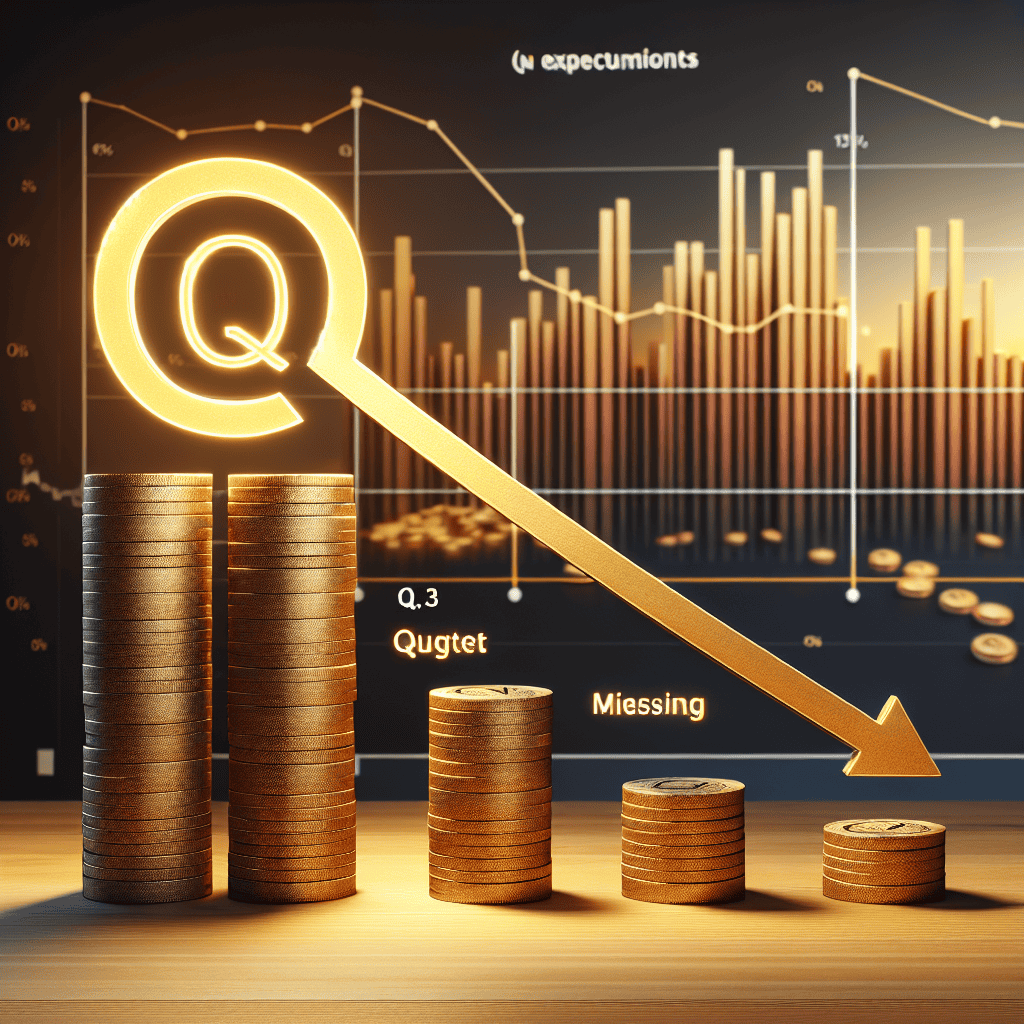“Equinor’s Q3: Profit Dips 13%, Falling Short of Forecasts”
Introduction
In the third quarter of the fiscal year, Equinor, the Norwegian energy giant, reported a 13% decline in profits, falling short of market expectations. This downturn was primarily attributed to fluctuating energy prices and operational challenges that impacted the company’s financial performance. Despite efforts to stabilize production and optimize costs, Equinor faced headwinds in the global energy market, which contributed to the disappointing financial results. The company’s earnings report highlighted the need for strategic adjustments to navigate the volatile energy landscape and sustain long-term growth.
Analysis Of Equinor’s Q3 Financial Performance
Equinor, the Norwegian energy giant, recently reported a 13% decline in its third-quarter profits, falling short of market expectations. This downturn in financial performance has sparked discussions among analysts and investors, as it reflects broader trends within the energy sector and highlights specific challenges faced by the company. The decline in profits can be attributed to several factors, including fluctuating energy prices, operational challenges, and strategic decisions made by Equinor in response to the evolving energy landscape.
To begin with, the volatility in global energy prices has played a significant role in Equinor’s reduced profitability. Over the past year, the energy market has experienced considerable fluctuations, driven by geopolitical tensions, supply chain disruptions, and varying demand levels. These factors have collectively contributed to an unpredictable pricing environment, making it challenging for energy companies like Equinor to maintain stable profit margins. Consequently, the company’s revenue streams have been impacted, leading to a noticeable dip in profits.
In addition to external market conditions, Equinor has faced internal operational challenges that have further affected its financial performance. Maintenance issues and production delays in some of its key projects have resulted in lower output levels, thereby reducing the company’s overall revenue. These operational setbacks underscore the importance of efficient project management and the need for Equinor to address any bottlenecks that may hinder its production capabilities. By optimizing its operations, the company can better position itself to capitalize on favorable market conditions when they arise.
Moreover, Equinor’s strategic decisions in response to the global shift towards renewable energy have also influenced its financial results. As the world increasingly embraces sustainable energy solutions, traditional oil and gas companies are under pressure to adapt their business models. Equinor has made significant investments in renewable energy projects, such as offshore wind farms and solar power initiatives, as part of its long-term strategy to transition towards a more sustainable energy portfolio. While these investments are crucial for the company’s future growth and alignment with global energy trends, they require substantial capital outlay and may not yield immediate returns. This strategic pivot, while necessary, has contributed to the short-term decline in profits.
Furthermore, Equinor’s financial performance must be viewed in the context of the broader energy sector, which is undergoing a transformative phase. The transition to cleaner energy sources is reshaping the industry, with companies facing increasing regulatory pressures and shifting consumer preferences. Equinor’s efforts to diversify its energy offerings and reduce its carbon footprint are commendable, yet they also present challenges in terms of balancing short-term profitability with long-term sustainability goals. As the company navigates this complex landscape, it must carefully manage its resources and investments to ensure continued financial stability.
In conclusion, Equinor’s third-quarter profit decline reflects a confluence of external market dynamics, internal operational challenges, and strategic shifts towards renewable energy. While the company has missed market expectations, it remains committed to its long-term vision of becoming a leader in sustainable energy. By addressing operational inefficiencies and strategically managing its investments, Equinor can enhance its resilience and adaptability in an ever-changing energy landscape. As the company continues to evolve, its ability to balance immediate financial performance with future growth prospects will be crucial in maintaining its competitive edge in the global energy market.
Factors Contributing To Equinor’s Profit Decline
Equinor, the Norwegian energy giant, recently reported a 13% decline in its third-quarter profits, falling short of market expectations. This downturn can be attributed to a confluence of factors that have collectively impacted the company’s financial performance. Understanding these elements provides insight into the challenges faced by Equinor and the broader energy sector.
One of the primary factors contributing to Equinor’s profit decline is the volatility in global energy markets. Over the past year, fluctuating oil and gas prices have created an unpredictable environment for energy companies. While prices had surged earlier due to geopolitical tensions and supply chain disruptions, recent months have seen a stabilization and, in some cases, a decline in prices. This has directly affected Equinor’s revenue, as the company relies heavily on the sale of oil and gas. Consequently, the reduced income from these commodities has played a significant role in the profit shortfall.
In addition to market volatility, Equinor has faced increased operational costs. The energy sector is experiencing a rise in expenses related to exploration, production, and maintenance activities. These costs have been exacerbated by inflationary pressures, which have driven up the price of materials and labor. For Equinor, maintaining its extensive network of offshore and onshore facilities requires substantial investment, and the increased costs have eroded profit margins. Furthermore, the company has been investing in new technologies and infrastructure to enhance efficiency and sustainability, which, while beneficial in the long term, has added to short-term financial burdens.
Another contributing factor is the regulatory landscape, which has become increasingly stringent as governments worldwide push for cleaner energy solutions. Equinor, like many of its peers, is navigating a complex web of regulations aimed at reducing carbon emissions and promoting renewable energy sources. Compliance with these regulations often necessitates significant capital expenditure, diverting funds from other potential profit-generating activities. While Equinor is committed to transitioning towards a more sustainable energy model, the immediate financial implications of these regulatory requirements cannot be overlooked.
Moreover, Equinor’s strategic shift towards renewable energy, while commendable, has also impacted its short-term profitability. The company has been actively investing in wind and solar projects, aligning with global trends towards decarbonization. However, these ventures typically have longer payback periods compared to traditional oil and gas projects. As a result, while these investments position Equinor for future growth and sustainability, they have yet to contribute significantly to the company’s current profit margins.
Additionally, external geopolitical factors have played a role in Equinor’s financial performance. The ongoing conflict in Ukraine and tensions in other key regions have disrupted supply chains and created uncertainty in energy markets. These geopolitical dynamics have not only affected commodity prices but have also led to logistical challenges, impacting Equinor’s ability to operate efficiently and cost-effectively.
In conclusion, Equinor’s 13% decline in third-quarter profits can be attributed to a combination of market volatility, rising operational costs, regulatory pressures, strategic investments in renewables, and geopolitical uncertainties. While these factors present significant challenges, they also underscore the dynamic nature of the energy sector and the need for companies like Equinor to adapt and innovate continually. As the company navigates these complexities, its commitment to sustainability and strategic growth will be crucial in shaping its future trajectory.
Market Reactions To Equinor’s Q3 Earnings Report
Equinor, the Norwegian energy giant, recently reported a 13% decline in its third-quarter profits, falling short of market expectations and prompting a range of reactions from investors and analysts alike. This downturn in profitability has been attributed to a combination of factors, including fluctuating energy prices and operational challenges. As a result, the company’s financial performance has become a focal point for stakeholders seeking to understand the broader implications for the energy sector.
The reported decline in profits has been met with disappointment by investors, who had anticipated a more robust performance given the company’s strategic initiatives and previous quarters’ results. Analysts had projected a more modest decrease, and the larger-than-expected drop has raised questions about Equinor’s ability to navigate the current market environment. This has led to a reassessment of the company’s strategies and future prospects, with some investors expressing concern over its capacity to maintain growth in a volatile market.
In response to the earnings report, Equinor’s stock experienced a noticeable dip, reflecting the market’s immediate reaction to the news. This decline in share price underscores the sensitivity of investors to earnings reports and the importance of meeting or exceeding market expectations. The company’s management has been quick to address these concerns, emphasizing their commitment to operational efficiency and long-term value creation. They have highlighted ongoing projects and investments aimed at enhancing production capabilities and diversifying energy sources as part of their strategy to weather current challenges.
Moreover, the broader energy market context cannot be ignored when analyzing Equinor’s performance. The global energy landscape has been marked by significant volatility, driven by geopolitical tensions, regulatory changes, and shifts in demand patterns. These factors have contributed to unpredictable price movements, which have, in turn, impacted the financial results of major energy companies, including Equinor. Consequently, the company’s earnings report is not only a reflection of its internal operations but also an indicator of the external pressures facing the industry.
Despite the disappointing earnings, some analysts remain optimistic about Equinor’s long-term prospects. They point to the company’s strong asset base, technological expertise, and commitment to sustainability as key factors that could drive future growth. Equinor’s efforts to transition towards renewable energy sources and reduce its carbon footprint are seen as positive steps in aligning with global energy trends. This strategic pivot is expected to position the company favorably in the evolving energy landscape, potentially offsetting short-term financial setbacks.
In conclusion, Equinor’s third-quarter earnings report has elicited a range of reactions from the market, highlighting both the challenges and opportunities facing the company. While the immediate financial results have fallen short of expectations, the broader context of the energy sector and Equinor’s strategic initiatives provide a more nuanced perspective on its future trajectory. As the company continues to adapt to changing market conditions and pursue its long-term goals, stakeholders will be closely monitoring its progress and the impact of its strategic decisions on financial performance. The coming quarters will be crucial in determining whether Equinor can successfully navigate the complexities of the energy market and deliver sustainable growth for its investors.
Equinor’s Strategic Adjustments Post-Q3 Results

Equinor, the Norwegian energy giant, recently reported a 13% decline in its third-quarter profits, falling short of market expectations. This downturn has prompted the company to reassess its strategic priorities and operational efficiencies. The results, which reflect a combination of fluctuating energy prices and operational challenges, have led Equinor to consider a series of strategic adjustments aimed at stabilizing its financial performance and ensuring long-term sustainability.
The decline in profits can be attributed to several factors, including volatile oil and gas prices, which have been influenced by global economic uncertainties and geopolitical tensions. Additionally, Equinor has faced increased operational costs, partly due to its ongoing investments in renewable energy projects. These investments, while crucial for the company’s transition towards a more sustainable energy portfolio, have temporarily strained its financial resources. Consequently, Equinor is now tasked with balancing its commitment to green energy with the need to maintain profitability in its traditional oil and gas operations.
In response to these challenges, Equinor is exploring various strategic adjustments. One of the primary areas of focus is enhancing operational efficiency across its existing oil and gas assets. By optimizing production processes and reducing costs, the company aims to improve its profit margins and better withstand market fluctuations. Furthermore, Equinor is considering divesting certain non-core assets to streamline its operations and free up capital for more strategic investments.
Simultaneously, Equinor remains committed to its long-term goal of transitioning to a more sustainable energy model. The company plans to accelerate its investments in renewable energy sources, such as offshore wind and solar power, which are expected to play a significant role in its future growth. By doing so, Equinor hopes to not only reduce its carbon footprint but also capitalize on the growing demand for clean energy solutions. This dual focus on efficiency and sustainability is central to Equinor’s strategy as it navigates the complexities of the current energy landscape.
Moreover, Equinor is actively seeking partnerships and collaborations with other industry players to enhance its technological capabilities and expand its renewable energy portfolio. By leveraging the expertise and resources of its partners, Equinor aims to drive innovation and achieve greater scale in its renewable projects. This collaborative approach is expected to yield significant benefits, both in terms of cost savings and accelerated project timelines.
In addition to these strategic adjustments, Equinor is also placing a strong emphasis on risk management and financial discipline. The company is implementing more robust risk assessment frameworks to better anticipate and mitigate potential challenges in the market. This proactive approach is designed to enhance Equinor’s resilience and ensure that it remains well-positioned to capitalize on emerging opportunities.
In conclusion, while Equinor’s third-quarter profit decline presents a challenge, it also serves as a catalyst for strategic realignment. By focusing on operational efficiency, sustainable investments, and strategic partnerships, Equinor is taking decisive steps to strengthen its position in the energy sector. As the company continues to adapt to the evolving market dynamics, its commitment to balancing profitability with sustainability will be crucial in achieving long-term success. Through these efforts, Equinor aims to not only meet the expectations of its stakeholders but also contribute positively to the global energy transition.
Impact Of Global Energy Prices On Equinor’s Earnings
In the third quarter of 2023, Equinor, the Norwegian energy giant, reported a 13% decline in profits, falling short of market expectations. This downturn in earnings can be attributed to the fluctuating global energy prices, which have significantly impacted the company’s financial performance. As a major player in the energy sector, Equinor’s results are often seen as a barometer for the industry’s health, and the recent figures have raised concerns among investors and analysts alike.
The global energy market has been characterized by volatility in recent months, driven by a combination of geopolitical tensions, supply chain disruptions, and shifting demand patterns. These factors have collectively contributed to the unpredictable nature of energy prices, which in turn has affected the revenue streams of companies like Equinor. The company’s reliance on oil and gas production means that any significant changes in the prices of these commodities can have a profound impact on its profitability.
During the third quarter, Equinor faced the challenge of navigating through a complex landscape where oil prices experienced both peaks and troughs. While there were moments of price recovery, they were often short-lived, leading to an overall decline in average prices compared to previous quarters. This decline in oil prices was exacerbated by a decrease in natural gas prices, which further strained Equinor’s earnings. The company’s exposure to these volatile markets underscores the inherent risks associated with the energy sector, where external factors can swiftly alter financial outcomes.
Moreover, Equinor’s performance was also influenced by operational challenges that arose during the quarter. Maintenance activities and unplanned outages at key production facilities led to a reduction in output, compounding the effects of lower commodity prices. These operational setbacks highlight the importance of efficient management and strategic planning in mitigating risks and ensuring stable production levels. Equinor’s ability to address these challenges will be crucial in determining its future financial performance.
In addition to these operational issues, Equinor is also navigating the broader transition towards renewable energy sources. As the global community increasingly prioritizes sustainability and carbon reduction, traditional energy companies are under pressure to adapt their business models. Equinor has made strides in this direction by investing in renewable energy projects and setting ambitious targets for reducing its carbon footprint. However, the transition is complex and requires significant capital investment, which can strain financial resources in the short term.
Despite the current challenges, Equinor remains committed to its long-term strategy of balancing its oil and gas operations with investments in renewable energy. The company’s leadership has emphasized the importance of maintaining a diversified portfolio to weather market fluctuations and capitalize on emerging opportunities. This strategic approach is designed to position Equinor as a resilient and forward-thinking energy company capable of thriving in a rapidly changing industry landscape.
In conclusion, Equinor’s third-quarter profit decline reflects the broader impact of global energy prices on its earnings. The company’s financial performance has been shaped by a confluence of factors, including volatile commodity prices, operational challenges, and the ongoing energy transition. As Equinor continues to navigate these complexities, its ability to adapt and innovate will be critical in ensuring sustained growth and profitability in the future. Investors and industry observers will be closely monitoring Equinor’s progress as it seeks to balance short-term challenges with long-term strategic goals.
Comparison Of Equinor’s Q3 Results With Industry Peers
In the third quarter of 2023, Equinor, the Norwegian energy giant, reported a 13% decline in profits, falling short of market expectations. This downturn in financial performance has sparked interest in how Equinor’s results compare with those of its industry peers. As the energy sector navigates a complex landscape of fluctuating oil prices, geopolitical tensions, and a global push towards renewable energy, understanding these dynamics is crucial for stakeholders.
Equinor’s Q3 results reflect a broader trend observed across the energy sector, where many companies are grappling with similar challenges. The decline in profits can be attributed to several factors, including lower oil and gas prices, which have been influenced by a combination of oversupply and weakening demand. Additionally, Equinor has been investing heavily in renewable energy projects, which, while promising for long-term sustainability, have yet to yield significant returns. This strategic pivot towards greener energy sources is a common theme among major energy companies, as they seek to align with global climate goals and reduce their carbon footprint.
In comparison, some of Equinor’s industry peers have managed to weather the storm more effectively. For instance, BP and Shell have reported relatively stable earnings, thanks in part to their diversified portfolios and strategic investments in both traditional and renewable energy sectors. These companies have also benefited from cost-cutting measures and efficiency improvements, which have helped to offset the impact of lower commodity prices. Moreover, their global presence has allowed them to capitalize on regional variations in energy demand, providing a buffer against market volatility.
On the other hand, companies like ExxonMobil and Chevron have faced challenges similar to those of Equinor, with fluctuating oil prices and increased operational costs impacting their bottom lines. However, these American giants have been able to leverage their extensive upstream operations to maintain a steady flow of revenue. Their focus on technological innovation and digital transformation has also played a role in enhancing operational efficiency and reducing costs.
Despite the current challenges, Equinor remains committed to its long-term strategy of transitioning towards a more sustainable energy future. The company has set ambitious targets for reducing carbon emissions and increasing its renewable energy capacity. This commitment is evident in its recent investments in offshore wind projects and carbon capture and storage technologies. While these initiatives may not provide immediate financial returns, they position Equinor as a forward-thinking leader in the energy transition.
In conclusion, Equinor’s Q3 profit decline highlights the complex and evolving nature of the energy sector. While the company faces significant challenges, its strategic focus on sustainability and innovation offers a pathway to future growth. By comparing Equinor’s performance with that of its industry peers, it becomes clear that diversification, operational efficiency, and strategic investments are key factors in navigating the current market landscape. As the energy sector continues to evolve, companies that can balance short-term financial performance with long-term sustainability goals are likely to emerge as leaders in the industry.
Future Outlook For Equinor Amid Profit Challenges
Equinor, the Norwegian energy giant, recently reported a 13% decline in its third-quarter profits, falling short of market expectations. This downturn has prompted analysts and stakeholders to scrutinize the company’s future outlook amid the current profit challenges. As the energy sector grapples with fluctuating market dynamics, Equinor’s performance is emblematic of broader industry trends, necessitating a strategic reassessment to navigate the evolving landscape.
The decline in Equinor’s profits can be attributed to several factors, including volatile oil and gas prices, which have been influenced by geopolitical tensions and shifting supply-demand dynamics. Additionally, the company’s operational costs have risen, partly due to increased investments in renewable energy projects. While these investments align with global sustainability goals, they have yet to yield substantial returns, thereby impacting short-term profitability. Consequently, Equinor faces the dual challenge of managing immediate financial pressures while positioning itself for long-term growth in a transitioning energy market.
In response to these challenges, Equinor is likely to intensify its focus on cost optimization and operational efficiency. By streamlining processes and leveraging technological advancements, the company aims to enhance productivity and reduce expenses. Moreover, Equinor’s commitment to digital transformation is expected to play a pivotal role in achieving these objectives. Through the integration of digital tools and data analytics, the company seeks to improve decision-making processes and optimize resource allocation, thereby bolstering its competitive edge.
Simultaneously, Equinor’s strategic pivot towards renewable energy sources is poised to shape its future trajectory. The company has already made significant strides in expanding its portfolio of wind and solar projects, reflecting its dedication to sustainable energy solutions. This transition is not only a response to regulatory pressures and environmental concerns but also a strategic move to capture emerging market opportunities. As global demand for clean energy continues to rise, Equinor’s investments in renewables are expected to yield long-term benefits, potentially offsetting the current profit shortfall.
Furthermore, Equinor’s exploration of new markets and partnerships underscores its proactive approach to growth. By forging alliances with other industry players and entering untapped regions, the company aims to diversify its revenue streams and mitigate risks associated with market volatility. These collaborative efforts are anticipated to enhance Equinor’s market presence and facilitate access to innovative technologies and resources, thereby strengthening its position in the global energy landscape.
Looking ahead, Equinor’s ability to adapt to changing market conditions will be crucial in determining its future success. The company’s strategic initiatives, coupled with its commitment to sustainability and innovation, position it well to navigate the challenges posed by the current profit decline. However, the path forward is not without obstacles, as Equinor must balance short-term financial performance with long-term strategic goals.
In conclusion, while Equinor’s recent profit decline presents immediate challenges, the company’s forward-looking strategies offer a promising outlook. By focusing on cost efficiency, digital transformation, renewable energy investments, and strategic partnerships, Equinor is poised to overcome current hurdles and capitalize on future opportunities. As the energy sector continues to evolve, Equinor’s adaptability and resilience will be key determinants of its sustained growth and success in the years to come.
Q&A
1. **What was Equinor’s reported profit for Q3?**
Equinor reported a profit of $2.47 billion for Q3.
2. **By what percentage did Equinor’s profit fall in Q3?**
Equinor’s profit fell by 13% in Q3.
3. **Did Equinor’s Q3 profit meet market expectations?**
No, Equinor’s Q3 profit missed market expectations.
4. **What were the main reasons for the decline in Equinor’s profit?**
The decline was primarily due to lower oil and gas prices.
5. **How did Equinor’s Q3 performance compare to the previous year?**
Equinor’s Q3 performance was weaker compared to the previous year, with a 13% drop in profit.
6. **What impact did the profit fall have on Equinor’s stock price?**
The profit fall led to a decline in Equinor’s stock price.
7. **What measures is Equinor considering to address the profit decline?**
Equinor is considering cost-cutting measures and strategic investments to address the profit decline.
Conclusion
Equinor’s third-quarter profit fell by 13%, missing market expectations. This decline can be attributed to various factors, including fluctuating energy prices, operational challenges, or increased costs. The missed expectations may impact investor confidence and could prompt the company to reassess its strategies to improve financial performance in future quarters.





